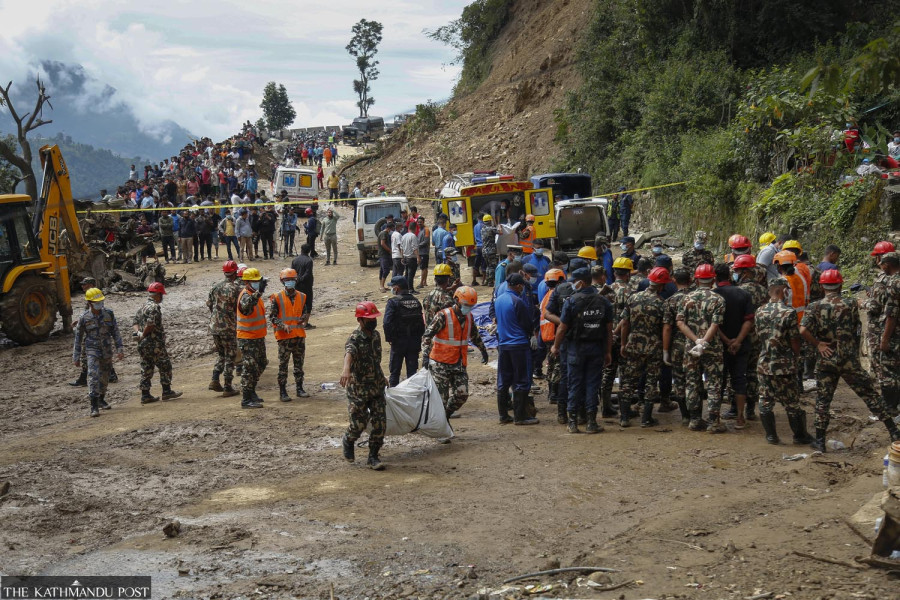Climate & Environment
Monsoon patterns have shifted. Authorities’ mindset has not
Had Met office’s warnings been heeded, more lives could have been saved, say experts.
Arjun Poudel
This time, the Meteorological Forecasting Division under the Department of Hydrology and Meteorology had alerted agencies concerned about changes in the weather system and the looming risk of disasters well in advance. But the authorities still failed to prevent widespread damage and loss of life.
Officials are still uncertain about the actual death toll and the amount of private and public property lost.
“We warned the public and agencies concerned about the looming risks and provided timely updates on changing weather systems,” said Bibhuti Pokharel, information officer at the department. “It seems that our message did not reach the target audience.”
At least 170 people have been confirmed dead, while 42 others are still missing in the flood and landslides triggered by record-breaking torrential rainfall starting Thursday evening. As many as 101 people have been injured, and more than 3,661 others have been taken to safe places, according to Nepal Police.
Data from the Department of Hydrology and Meteorology also shows a significant shift in monsoon patterns. Monsoon withdrawal, which used to happen in September, has been delayed to October since 2013. This trend is not confined to Nepal as many countries in the region are also experiencing extended monsoons. Experts predict a similar delay this year.
Shifting rainfall patterns, a part of climate change, have led to increasingly erratic weather—ranging from extreme rainfall over short periods to prolonged dry spells—wreaking havoc across Nepal over the past decade and a half, affecting thousands of people and threatening livelihoods.
“Accurate weather predictions will be vital for disaster preparedness,” said Dr Indira Kandel, a climate expert. “The Met office has issued timely forecasts and updates, but the real issue is how the agencies concerned interpret and act on the information.”
Floods submerged many parts of the Kathmandu Valley and other districts, with landslides and floods destroying homes, vehicles, bridges, and highways.
“Had authorities taken our warning seriously, the losses could have been reduced. Landslides would not have buried passenger buses,” said an official at the Department of Hydrology and Meteorology, asking not to be named, as he feared retribution for speaking out. “People living along riverbanks could have been evacuated to safety in advance.”
Even the directives to halt night bus services were ignored in many places, due to which dozens of people died.
“This disaster is not just a result of extreme weather, it’s also a failure of our lethargic bureaucracy,” said Madhukar Upadhyay, a climate expert. “The climate has changed but our approach remains stuck in the past. We can’t save lives by just counting the dead.”
Experts say unless the agencies concerned take prompt action, better weather forecasting will make little difference. They say agencies under all three tiers of government must coordinate to effectively respond to disasters.
“We must bridge the gap between the Met office’s forecasts and how the implementing agencies operate,” said Upadhyay.
Nepal is one of the world’s most vulnerable countries to the climate crisis and has witnessed extreme weather events over the past decade and a half.
Evidence suggests that the maximum temperature in Nepal is rising at a greater rate (0.056 degrees Celsius per year) than the global average of 0.03 degrees Celsius per year.
Experts say extreme weather events—excess rainfall in a short period, continuous rains for several days after the monsoon, dry spells, droughts, below-average precipitation, and above-normal winter temperatures—have become more frequent in Nepal.
The monsoon season in Nepal generally begins on June 13 and ends on October 2. This year, the clouds from the south entered Nepal from the western region on June 10, three days ahead of the usual onset date. Last year, the weather phenomenon started on June 14, a day prior to the normal onset day.
The monsoon season, which delivers around 80 percent of the country’s total annual rainfall, generally lasts 105 days. But, in recent years, it has been taking more time to withdraw.
Record-breaking rainfall
According to the department, 25 weather stations in 14 districts witnessed record-breaking rainfall for 24 hours on Saturday. Data show that the weather station at the Tribhuvan International Airport recorded 239.7 millimetres, the heaviest recorded in the past 22 years.
Earlier, on 23 July 2002, the weather station recorded 177 mm rainfall. Along with the TIA weather station, those at Panipokhari, Budhanilkantha, Jitpurphedi, and Nagarjun hill in Kathmandu also witnessed record-breaking rainfall.
The weather station at Khopasi of Kavrepalanchok recorded 331 mm of rainfall. Earlier on 3 September 2015, the same weather station recorded 276.9 mm. Panchkhal and Dhulikhel of Kavrepalanchok district also witnessed record rainfall.
Chapagaun and Godawari of Lalitpur district recorded 323.5 mm and 311.6 mm of rainfall, respectively, the highest in 22 years. On 23 July 2002, the weather station had recorded 200.5 and 225.2 mm of rainfall, respectively.
The Daman hill station in Makawanpur district recorded 410 mm of rainfall, the highest in the last 31 years. On 20 July 1993, 373.2 mm of rainfall was recorded.




 20.12°C Kathmandu
20.12°C Kathmandu















